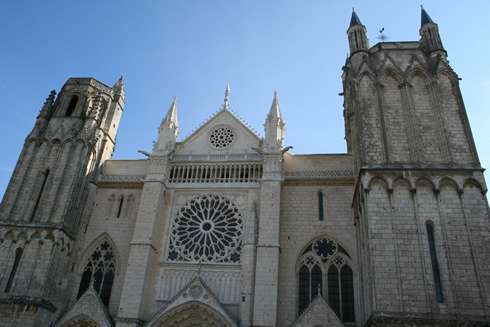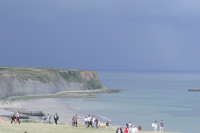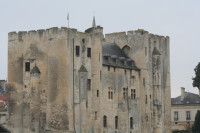In the name of God - the world of cathedrals
Understanding the world of cathedrals: the Cathedral Saint Pierre of Poitiers (France)

Amazingly, 80 cathedrals were built in France between the 12th and 13th centuries. One of them is the magnificent Gothic Cathedral Saint Pierre of Poitiers, located in the Southwest, halfway between Paris and Bordeaux.
Henry Plantagenet and Alienor of Aquitaine
Construction began on the site of the city’s first cathedral under the new bishop and friend of Henry of Plantagenet, (Henry II of England) Jean-aux-Belles-Mains. Although we know with certainty that fire ravaged the original one, built in the 4th century, and it was rebuilt many times, we have no idea what pushed the commissioners to have the last one, just inaugurated in 1025, demolished and rebuilt. The last Roman cathedral had just been rebuilt after the 1018 fire. Up until the reconstruction of the new Gothic cathedral, it is really unclear what happened.
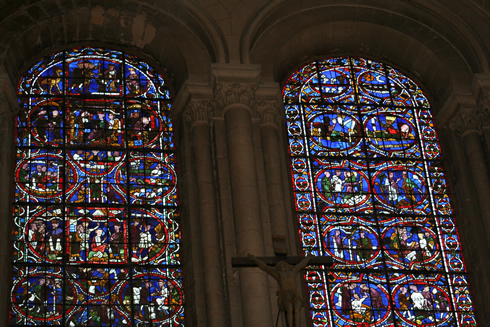
Stained glas windows in the Cathedral St Pierre of Poitiers, France
According to various sources, Henry Plantagenet, the King of England, commissioned it for his wife, Alienor (Eleanor) of Aquitaine. While some historians believe that Alienor laid the first stone in 1162, others rather believe it could have happened slightly before.
The royal couple supposedly donated the Crucifixion stain-glass window, as a Latin inscription shows it was a gift. Moreover, Henry and Alienor are portrayed at the bottom of the 12th century window. This is quite difficult for the visitor to notice, as the part showing the portrait of the king and queen is hardly noticeable due to the railing covering it.
Stain-glass window and vaults
Today this stain-glass window belongs to the oldest one of all stained glass windows in France and is still intact.
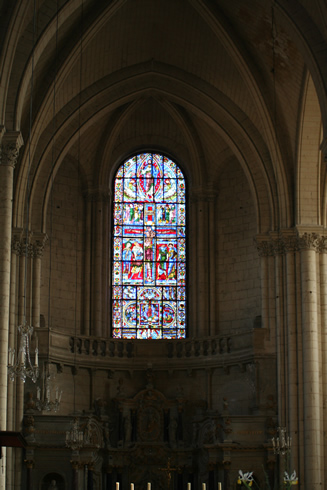
Cruxifiction stained glass, Cathedral St Pierre in Poitiers
Alienor ordained the architect to start with the eastern wall, which was completed within five years. It went relatively fast at the beginning and it was almost all completed after 40 years.
But what was left to do? Among other things, there were the doorways, finished mid 13th century and the work on the facade towers, completed later in the 16th century. Until its consecration under the bishop Saint Pierre in the Fall of 1379, more than two centuries had gone by since the beginning of the project, interrupted several times mainly due to a lack of finances and to wars.
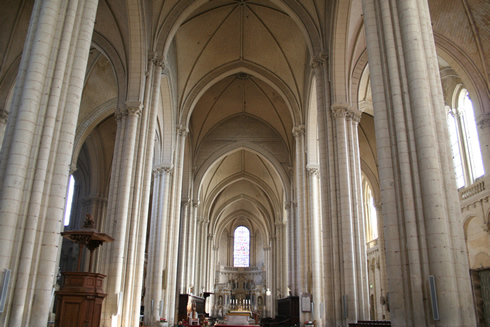
Inside of the Cathedral St Pierre, Poitiers
The voluminous aspect of this cathedral strikes the visitor. The vaults weigh between 100 to 120 tons each. It is composed of three naves like other regional Roman cathedrals. The Saint Pierre Cathedral is not very long with only 328 feet and not high with only 98 feet (not comparable to Amiens cathedral with a height of 160 feet), but it is quite wide with 164 feet.
Plantagenet influence and Gothic Angevin
Known as a Gothic Plantagenet cathedral, because of its English influence (ribbed bulging vaults, indirect light), the later part of the construction saw some differences in its original style. The Parisian Gothic, also called Capetian or Northern Gothic, which was competing at the time against the Gothic Plantagenet finally broke into the region when the bishop, Jean de Melun, arrived in Poitiers. The three doorways, the two towers of the facade, the Rose window and the occidental facade are all Parisian Gothic. The sculptors copied the work done in Paris and in Reims.
�
“The cathedral of Poitiers could be considered as the boldest creation of Gothic Plantagenet …it was too original to often be reproduced elsewhere,”
writes French Abbot Yves Blomme in 1994 in an archeological magazine.
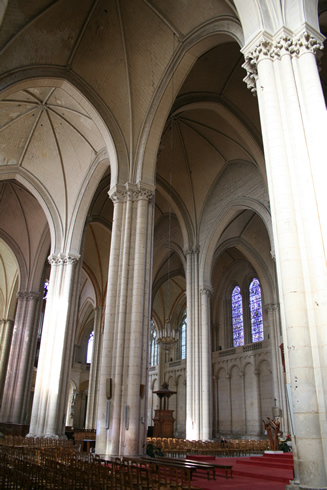
A French historian also notes that what makes it so original is its trapezoid shape and its extremely flat apse (chevet), much more different than any other English cathedral.
While visiting the Saint Pierre Cathedral, one should not miss the 13th century stalls. Offered by Jean de Melun, they are the oldest ones in France and are beautifully carved with angels, animals and people motifs.
Clicquot and Trompe l’oeil sculptures
Furthermore, it possesses an organ in perfect condition known as the Clicquot organ because it was made by the Clicquot family. There are only about three like this one in France. Poitiers’ clicquot was made in 1787 by François Henri Clicquot.
Many various renovations have taken place over the years to preserve this national monument. During the cleaning of the vaults, one discovered that the walls had been originally painted. In the entrance, very colorful and beautiful Trompe l’oeil sculptures are noticeable. At the end of the 18th century, the walls had been covered with whitewash, which is now slowly peeling off. However, today, because of a lack of finances, there is no renovation project planned for the Cathedral Saint Pierre of Poitiers. Fortunately, according to a town heritage’s expert, the cathedral is in no danger of further deterioration at this time.
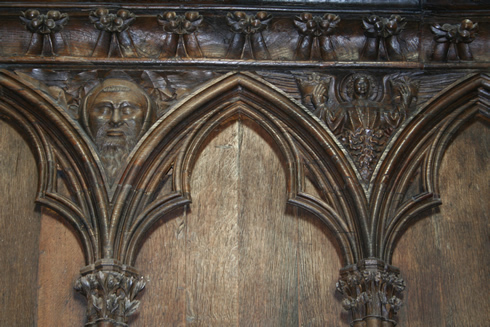
Medieval stalls in Cathedral St Pierre, Poitiers
“Manhattan of Europe”
Like the Cathedral Saint Pierre of Poitiers, many Medieval cathedrals around the world have fascinated experts other the years, trying to always learn more about the missing pieces.
The time of the cathedrals, compared by some to the time of the pyramids of Egypt had started in France in the department of Oise (in Northern of France in the Picardie region), also known as the “Manhattan of Europe”.
It continued its way to other European countries, but depending on the regions and countries where the cathedrals were built, the style differed greatly. Many cathedrals were unfortunately never finished or ended looking quite different as their original plans.
Nevertheless the interest in these gigantic and intriguing medieval buildings is certainly going to continue for a long time to come.
